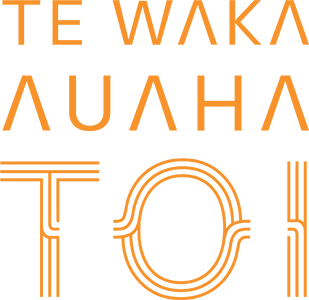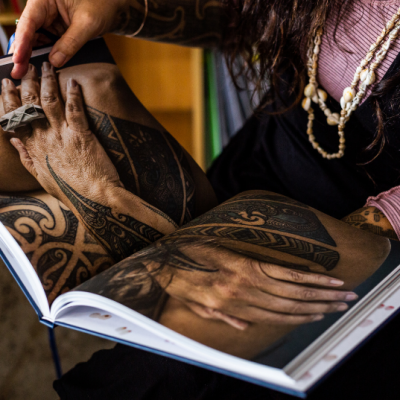Creative Patapatai
‘Mindscapes: Portraits of Mental Health’ is a group exhibition where art and mental health converge. Through portraiture, nine artists explore the nature of mental wellbeing, encouraging viewers to reflect on their own experiences and those of others. Timed to coincide with World Mental Health Day and New Zealand Mental Health Awareness Week, the exhibition highlights the importance of mental health conversations.
In this interview, artists Andrea Green, Anna Solich, Cordula Taiwo, Jody Linton, Liam Atkins, Lou Agas, Michelle Estall, and Paul Cornwell share how creating these portraits has impacted their wellbeing and how they hope their work can spark important conversations around mental health.
‘Mindscapes: Portraits of Mental Health’ is showing from 28 September to 19 October at The Incubator Gallery. Opening night is 27 September, 5:30pm.
Your occupation, job title, artistic discipline (or very brief description of what you do):
Andrea Green: I am a New Zealand-born artist with a fascination with portraiture. I work from my home studio in Ōropi, as well as at The Portrait Studio in Tauranga’s Historic Village. I undertake live pastel portrait sittings as well as commissions, and always try to express personality and emotion in my artworks.
Anna Solich: I am a full-time mum and an artist. I experiment in a range of different medium and styles.
Cordula Taiwo: I am a self-taught artist who is constantly drawn to the human experience – our shared joys, sufferings, hopes and dreams. As such, I paint portraits to capture connection, compassion and the depth of the human spirit.
Jody Linton: I am a freelance animator, digital artist and designer.
Liam Atkins: I am a Brazilian jiu-jitsu coach and personal trainer, and am working towards being in the social sector. I class myself as a creator and I love to experiment. If I was to say what I am at the moment – I am a mask sculptor!
Lou Agas: I am a motion graphic designer. Video editing is part and parcel of that work. Painting is what I do in between projects.
Michelle Estall: I am a visual artist of European, Croatian, and Māori descent (Te Rarawa and Te Aupōuri). I am currently studying Toi Paematua through Te Wānanga o Aotearoa which I am really enjoying, while also trying to maintain an art practice. I currently work in acrylic and oil paints. I often paint portraits as they celebrate the diversity of our experiences but are also windows into the shared humanity that binds us all together.
Paul Cornwell: I am a self-employed graphic designer and illustrator with a pretty big chunk of painting on the side.
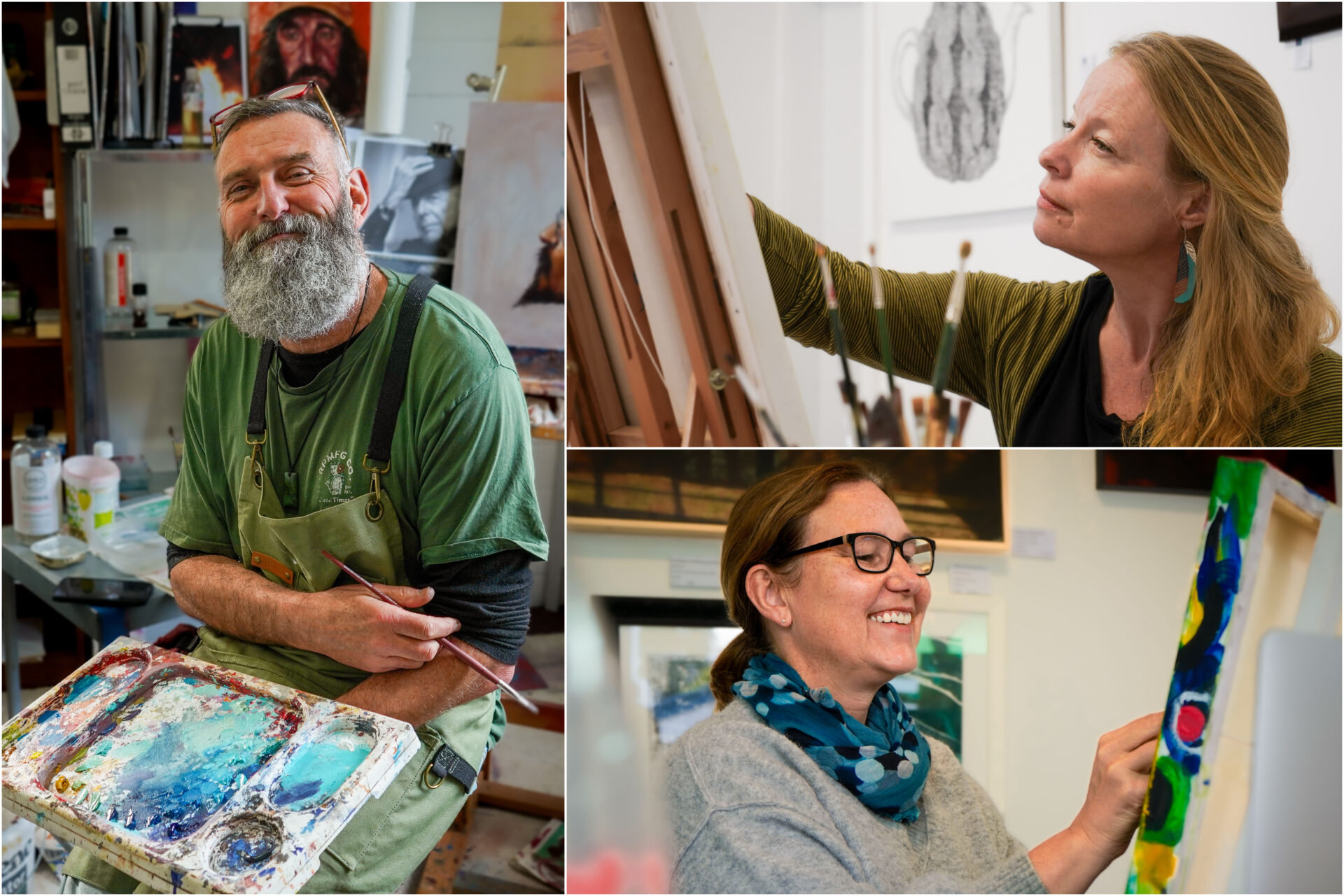
In what ways has the act of painting these portraits impacted your own sense of wellbeing and self-reflection?
Andrea: The two paintings that I will be exhibiting in this exhibition are both in oil, however they bring entirely different messages around mental health and wellbeing. One is a personal taonga of my grandson with his other Nanny, with whom he has a powerful bond. It is an honouring of that mutualistic relationship. The other painting is a reminder of the importance of humour!
Anna: I began painting just over four years ago, at a time where I was delving deeper within myself and relearning who I was and what I want for my life. The portraits I create are a direct reflection of how I’m feeling at that time. Every brush stroke holds an emotion. The face isn’t a self portrait, but the emotion is. It’s like a diary entry for me. It can be a really intense, draining, outpouring of feeling, which I need to release. It can leave me exhausted and unable to paint for a few weeks after each piece. I’ve come to understand and listen to myself and what my work is telling me. It is most certainly my therapy.
Cordula: My first painting of ‘The Counsellor’ originated in a body of work called Art Seeks Wisdom which took me roughly 18 months to complete. During that time, I learned many valuable lessons about myself, the creative process, identity, people and the wisdom of a multitude of voices within Aotearoa New Zealand. Yet, I also misused my body. Working so many hours on these portraits and the obligatory social media content on top of my full-time job took a toll on my neck, my left shoulder and my back; and I ended up in a lot more pain than I normally experience due to poor breathing habits, bad posture, and a lack of strength. Luckily, I found a really good chiropractor, an equally wonderful physiotherapist, committed to regular treatment, the prescribed daily exercises, twice weekly pilates lessons, a bare minimum of anti-inflammatories and the odd yoga class. I also self-regulated not only my use of social media, but also my sleeping patterns. Most importantly, I prioritised time spent with friends and family over mindlessly tumbling further into my creative endeavours. Now I feel again attuned to the many joys of the journey and ready to commit to more than my own needs and my immediate surroundings. I am currently working on my second piece for the exhibition. ‘UOKBRO?’ is a portrait of Scott Harvey, a social worker who sits next to his car on the side of the streets of New Zealand and talks to anyone who might need a listening ear.
Jody: An increased awareness of the need to take timeout and getting outside of the daily routine of being in front of a screen all day.
Liam: Looking inward always stirs things up emotionally, but I think shifts in my mood help with my creativity and I think I’ve created some impactful pieces.
Lou: I realised that I had it easy and had a shallow understanding of mental health. In the last few months, I believe I became more aware of how people behave or react to me. I’m also consciously trying my best not to judge others quickly. And at the same time, making sure I pause and just breathe.
Michelle: Creating these pieces took a great deal of self-reflection as they are self-portraits. It made me revisit darker periods of my life, such as witnessing the decline in my father as he lived with dementia, grieving the loss of my parents and an ongoing struggle with my own depression and anxiety. Tough emotions to portray and share. However, it also made me examine the things that have helped me move through these times. The common thread to getting through my darkest moments has been by learning to speak up and share with others what I am going through and allowing others to support me on my journey. Isolating myself was unhelpful to my mental health, so I have found returning to studying toi (art) has been a wonderful way to forge friendships, keep my mind active while learning and maintaining a creative outlet to work through emotions.
Paul: It’s not easy to articulate because I guess with my two portraits of Hone Tuwhare there isn’t an obvious or direct link to mental wellbeing. It’s more about what finding out about people like Hone did for me personally. I think it gave me a deeper sense of appreciation for New Zealand artists and poets from our past who forged ahead with their own path even though it was probably quite counterculture to the time and place they were living in. I think it’s their example I appreciate. In turn, I feel better about my own path and enthusiastic about trying to avoid the many snares of our hectic, materialistic, Westernised society, which in turn aids my own sense of wellbeing.
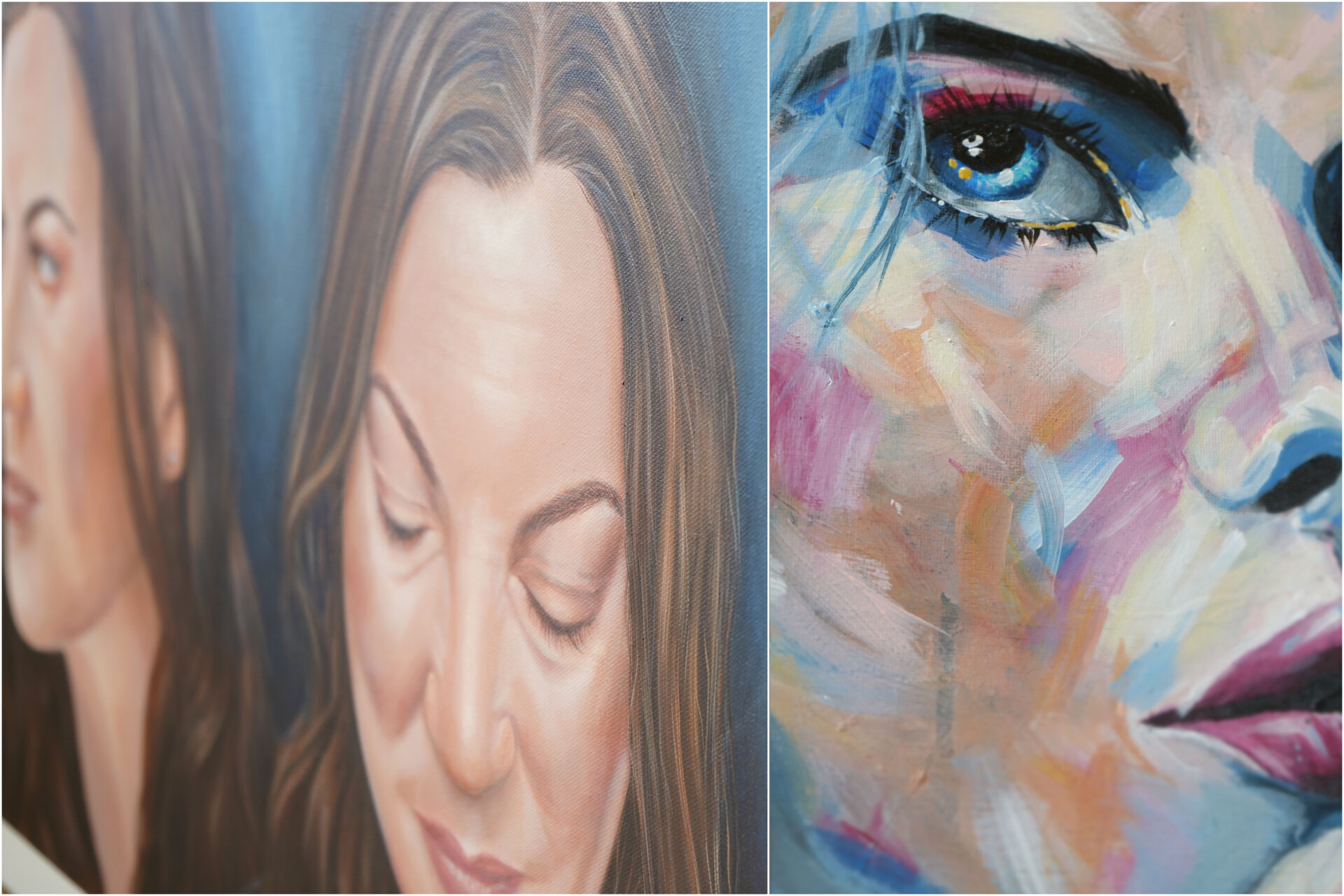
What challenges have you faced, both personally and professionally, in creating this emotionally-charged body of work?
Andrea: The biggest challenge for me around these works was actually time. My ADHD brain is a constant creative motor which regularly prompts new ideas. I have trouble keeping up with myself and have a lot of internal self talk that I can only do my best! But time was definitely the word in my mind during this process. And that I don’t always make the most of it!
Anna: I guess my main challenge is allowing myself to be vulnerable, and allowing people access to that vulnerability… and trusting that it is okay to be so open.
Cordula: The main challenge is to stay within the genuine flow of ‘the thing’ one is trying to bring to life. It is so easy to deceive oneself and others by trying to say something profound instead of actually creating and saying something true and of value. There are so many traps one can fall into, and I got plenty wrong along the way. However, I managed to stay on the path, did not stray too far from what I think is important in my art and I learned many lessons from my art friends and their invaluable advice. I also embraced the unexpected whenever it presented itself. I guess that is worth something.
Jody: My main challenge was composing the ideas for each piece in a positive, light, forward-thinking way.
Liam: I’ve experimented a lot with new materials which has tested my limits and caused me to alter my work frequently during creation.
Lou: Talking with people experiencing mental health struggles taught me that this is a very complex subject. I quickly realised I underestimated the task and felt I was out of my depth. For a while there, I was stressed out and could not paint. The decision to not let the task overwhelm me helped tremendously. I guess that’s art imitating life and life imitating art.
Michelle: I think exposing my own vulnerabilities was the hardest thing. I considered painting someone else as my subject, but mental health is such a personal journey, I felt like someone else’s journey was not my story to tell. In my portraits for ‘Mindscapes’ I am reflecting on my own experiences with depression, anxiety and grief. Recognising patterns since childhood where I was painfully shy and never really felt like I fit in and how that has translated into shaping the adult I am today. Contemplating ways to rewrite the script that we tell ourselves in our minds is the subject of one of my portraits for this exhibition entitled letter to my younger self.
Paul: I don’t feel my pieces are emotionally-charged. It was a pleasure being immersed in them. The only real challenges where the technical sides to oil painting, trying to keep the expressive brushwork going, and managing the flaws in my technique.
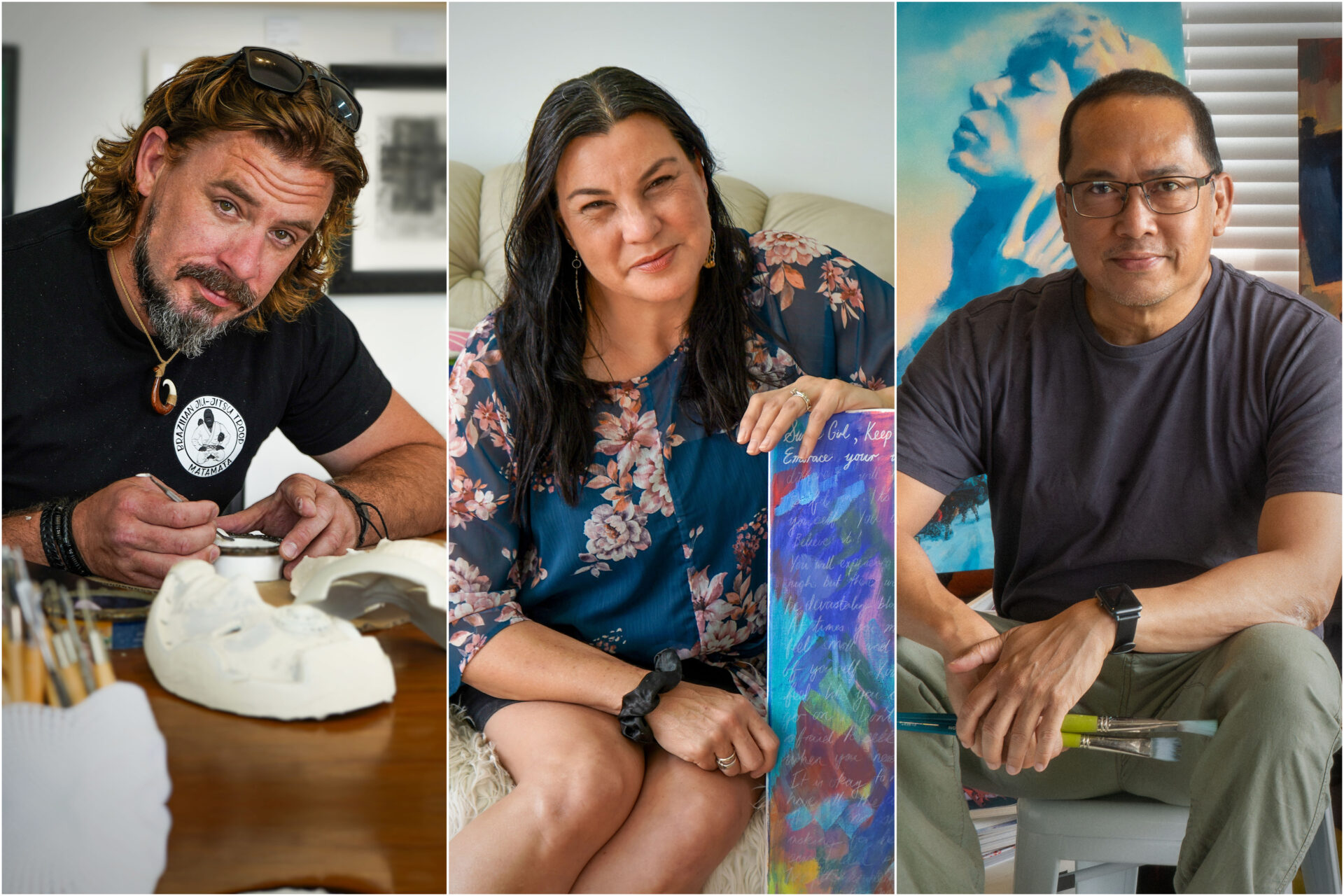
What do you hope viewers will take away from engaging with these portraits and the stories they tell?
Andrea: This will be such a diverse collection of works, with many emotional messages – and who can say how things are received. But I hope overall that we are permissioning ourselves and others to be vulnerable in opening up our emotions. To be kind to ourselves and others, as we all face struggles and we need to remember to laugh as well as cry – as we journey this together.
Anna: My hope is for even just one person to connect with my work: either it inspires them to pick up paint brushes, use art as their therapy, or to begin a conversation around their own feelings and wellness. To make a connection.
Cordula: I hope these portraits inspire viewers to look for, recognise and acknowledge good people within our communities. By highlighting individuals who offer hope, kindness, and support, I want to remind us that we all have the capacity for compassion and a more understanding, forgiving view of humanity. We need to work together to create a more supportive and compassionate society. I also want to shout out to all who work so tirelessly in increasingly impossible circumstances within our eroding health care systems. Kia kaha. We appreciate you! Beyond that, I hope to remind those who benefit greatly from what has become a very greedy health and wellness industry that we are all people, not just bank accounts, insurance claims, cases or organisms in disorders.
Jody: I hope they come away with the idea of nature as a source of inspiration, peace, recovery and nurture.
Liam: I hope they draw their own feelings from these pieces and their brief titles.
Lou: To realise that we all have struggles, although some may be more susceptible than others. But the good news is that people care. People understand. It is not taboo anymore to seek help. Heck, we all need help.
Michelle: My biggest hope for anyone that views the exhibition and may be going through a low period currently is that they recognise they are not alone. I would love their biggest takeaway to be hope. It is okay to not feel okay, but please don’t keep it to yourself. While low periods are part of the human experience, when you feel like your mental health is declining there is no shame in asking for help. At some point we will all be affected by mental health, if not us then someone we know. Being there for each other is what matters. Embracing the richness of individuality and recognising the potential that lies within us all.
Paul: For those that haven’t heard of Hone Tuwhare, they may get to learn a little about him. And for those that have, be reminded of the calibre of his work. Perhaps to dig into our New Zealand history of painters and poets and appreciate the way they lived and the challenges they faced pursuing their craft. And for themselves, maybe they are encouraged to lean into words or mark-making and find quiet spaces to help express the things that are challenging or important to them.

How do you believe art can serve as a powerful medium for raising awareness and destigmatising conversations around mental health?
Andrea: Someone once commented about how unfair it is that painters have to describe themselves and their works, yet writers are never expected to illustrate their books! How true that is, and I believe the whole point of art is that it expresses what words cannot.
Anna: For me, as I’ve mentioned, art is therapy. I don’t keep a diary, my pages and pages of artwork is how I become tuned in to what’s going on in my mind, heart and soul. For some people, it’s not always easy to speak openly about their struggles, but to be able to paint, make, or draw an emotion is crucial in being able to expressing yourself and possibly opening a conversation around wellness.
Cordula: In a world that bombards us with words and images, where any singular thing can be turned into its own meme with the push of the button, it is difficult to think of mental health or awareness on any scale. Art, to be honest, seems like an indulgence, and maybe it is. Maybe it is time to put the ‘medium’ to the side and to minimise conversation in favour of creating a space in which awareness and mental health can flourish? I don’t know.
Jody: Art is very expressive to me, it can help communicate ideas that I struggle to communicate verbally. It can be a way to create a conversation with the viewer and asking them to consider a perspective on an idea – hopefully it gets them being more open about thinking and talking about mental health and wellbeing.
Liam: Art is a fantastic discussion medium and can turn a person inwards to reflect on their own struggles and potentially open up a discussion about a piece.
Lou: Art is a form of communication (visual art, music, poetry, etc.) in different styles with different messages. Every work will always find that one person that resonates with it. That starts the conversation.
Michelle: Art is a conversation starter. Art has the power to evoke an emotional response and make us think. Hopefully, the exhibition showcases that if you are having mental health issues of your own, you are not alone. Sometimes when we see a painting, read a piece of poetry or listen to the lyrics of a song we find ourselves feeling seen and we can relate to the emotion or message. That is the power of art. Art can offer comfort in tough times. In addition to this the act of creating is one of the best ways I have found to harness those emotions and work through them, so perhaps it could inspire others to find their own creative outlet.
Paul: I can only speak to what I have experienced either in myself or those around me. For the artist, it requires the working out of an idea. The time involved and the reflective nature of mark-making can be healthy and constructive. And then by having the artwork brought into a wider public arena we just bring these things to the surface. It’s not hidden or secret but open for consideration and discussion.

What word of advice would you offer an aspiring creative person?
Andrea: I would say, work hard. Devote yourself and work harder than you think that you need to. Do not wait for inspiration, it will find you working. I think someone famous said that, but I can’t remember who…!
Anna: My advice for aspiring creatives… just do it. If you feel it… do it. Do it for yourself. No one has to see your work. There are no rules. No right or wrong. Play like a child. Just make a start and feel the magic inside you start to emerge. It’s so exciting.
Cordula: Enjoy your life. Enjoy your art. Enjoy your journey. Take good care of yourself and your whānau. Maybe you will never make a living from your art! So what?! So few of us do. I am certain that the people who painted the cave paintings of old didn’t expect a steady income stream. Your life and well-being is more precious than all the masterpieces you could possibly create in a lifetime combined. I am a little embarrassed, because I don’t really know the origins of this proverb, but I truly believe that the most important thing in any society – ‘It is people, it is people, it is people!’ He tangata, he tangata, he tangata.
Jody: Follow your heart and gut feeling. Trust yourself and be open.
Liam: Create for yourself! Also, experiment with different mediums and don’t limit creativity to expensive, out-of-reach mediums. Create with whatever you can get your hands on.
Lou: It’s a noisy world out there. A lot of times we are bombarded with comments, suggestions, and feedback on how to handle our art and careers. Oftentimes it weighs us down. Or burns us. We just have to remember to slow down and take care of ourselves. A clear mind and wellbeing come first.
Michelle: Just do it! Whatever the medium, creativity is the best outlet for emotions and the simple act of making something has been a huge help to me personally to express myself, let things out and let them go. I also highly recommend joining a class, whether that is a one off day class to get yourself inspired, a hobby class or full time study. Connecting with other creatives can build up your confidence and you can learn so much from others.
Paul: First and foremost you need to make stuff for yourself. Not for ‘likes’, approval, applause, ego, money. Those motivators wont get the best out of you. I often ask myself when starting a new piece, ‘would I pursue this piece if I knew no-one would ever see it or appreciate it?’. If the answer is ‘yes’ then my motives are true and I’ll have the enthusiasm and drive to see it through and navigate the challenges along the way. Of course it is nice having peoples applause and eyes on my work, but it can not be my key driver. The work and my character will suffer if it is.
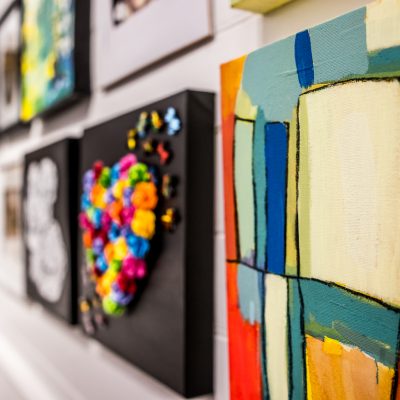
Creative Directory
Explore and connect with creative people, groups & spaces in Tauranga and Western BOP
